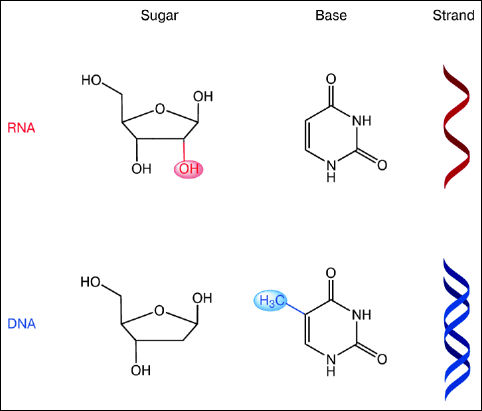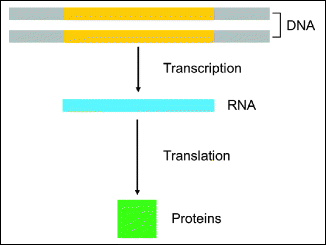, Maneli Mozaffarieh1 and Hans Bebie2
(1)
Department of Ophthalmology, University of Basel, Basel, Switzerland
(2)
Institute for Theoretical Physics, University of Bern, Bern, Switzerland
Abstract
Ribonucleic acid (RNA), like DNA, is also a macromolecule made up of nucleotides, although it is shorter. However, in contrast to DNA, RNA has the base uracil instead of thymine and it contains ribose instead of deoxyribose sugar (Fig. 15.1).
Ribonucleic acid (RNA), like DNA, is also a macromolecule made up of nucleotides, although it is shorter. However, in contrast to DNA, RNA has the base uracil instead of thymine and it contains ribose instead of deoxyribose sugar (Fig. 15.1).


Fig. 15.1
Differences between DNA and RNA. Left: While the sugar present in a DNA molecule is deoxyribose, the sugar present in a molecule of RNA is ribose. Middle: DNA has the base thymine, whereas RNA has uracil as one of the bases. Right: DNA is double-stranded, whereas RNA is single-stranded
The sequence of the nucleotides in RNA is determined by transcription from the DNA. The sequence in the RNA, in turn, determines the sequence of amino acids by translation. During translation, information in the language of nucleotides is “translated” into information in the language of amino acids (Fig. 15.2). As discussed later, three different kinds of RNA play a role in the synthesis of proteins.


Fig. 15.2
Transcription and translation. The DNA becomes copied (transcription) onto an RNA chain; the RNA controls protein synthesis (translation)
15.1 Discovery of RNA
15.2 Structure and Function of RNA
Three different kinds of RNA molecules are important. The role of the so-called messenger RNA (mRNA) is to carry the information from DNA to the ribosomes. The role of transfer RNA (tRNA) is to bring the amino acids to the ribosomes. Finally, the role of the third type of RNA, ribosomal RNA (rRNA), is to build a structural and functional component on which translation can take place. More details on these three kinds of RNA are now discussed.
15.2.1 Messenger RNA
Messenger RNA (mRNA) carries the information from the cell nucleus to the ribosomes in the cytoplasm, where protein synthesis takes place. Similar to DNA, genetic information in mRNA is encoded in the sequence of nucleotides that are arranged into codons. Each codon consists of three bases and codes for a specific amino acid.
15.2.2 Transfer RNA
Transfer RNA (tRNA), the smallest of the three major RNA molecules, brings the amino acids to the ribosomes. The tRNA carrying the amino acid makes up the anticodon. The anticodon binds to a specific amino acid and brings it to a ribosome. For every amino acid, there is at least one but often more tRNA molecules.
15.2.3 Ribosomal RNA
The ribosome itself interacts with both the mRNA and the tRNA, thereby catalyzing the formation of a peptide bond between the two amino acids, as illustrated in Fig. 15.3.


Fig. 15.3
Formation of a peptide. During translation, specific tRNAs pick up specific amino acids, transfer those amino acids to the ribosomes, and insert them in their proper place according to the mRNA code. This is done by the anticodon portion of the tRNA molecules complementarily base pairing with the codons along the mRNA
15.3 RNA and Cell Function
Gene expression is important for any living cell but has a particular impact during embryology where the different cells mature into different cell types. Think for a moment about how, for example, a cell, starting from just a single fertilized egg cell, becomes a living animal. Imagine that a fertilized egg cell has already divided and now consists of eight cells. How does each cell know in which direction it has to develop? Will this cell finally contribute to the growth of the head or the creation of a foot? Until recently, the answers to these questions were a great mystery to biologists. However, during the past several years, insights have been gained into the regulation of embryonic development. Today, we know that this is achieved by the establishment of a certain hierarchy among the genes involved, where the gene products of the first gene regulate the expression of subsequent genes.
Much of our understanding in this area is owed to the work of the German biologist Nüsslein-Volhard (Fig. 15.4).4
 < div class='tao-gold-member'>
< div class='tao-gold-member'>





Only gold members can continue reading. Log In or Register to continue
Stay updated, free articles. Join our Telegram channel

Full access? Get Clinical Tree


